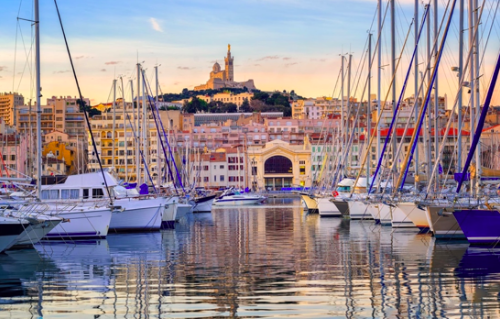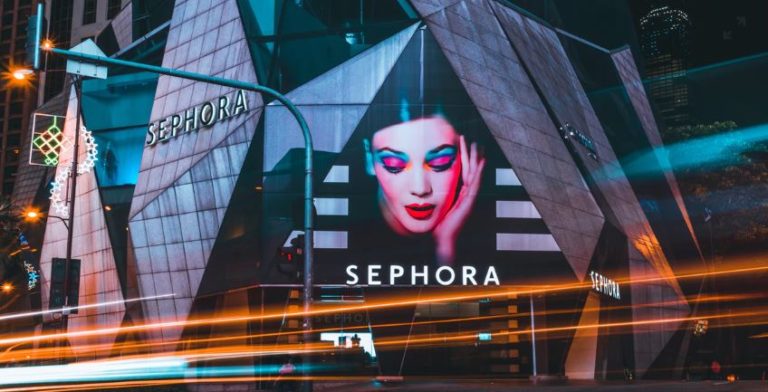Marseille, France’s second largest city is located in southeastern France. Facing the Mediterranean, the exotic atmosphere and bustling economy makes the city a paradise for Chinese tourists and investors. China’s robust economic advancements make traveling to France available for the middle class. The number of Chinese people who traveled to France in 2018 reached a new record of 2.2 million. During their 6 days’ average stay, in total, Chinese tourists spent more than 4 billion Euro in the country.
Moreover, Marseille has a significant soft power among Chinese people, which is especially apparent in football, film, literature, and beauty. Famous brands and products from Marseille such as Marseille soap and wine and brands like L’Occitane, Compagnie de Provence and Le Petit Marseillais have a glowing reputation in China. Meanwhile, businesses like Airbus Helicopter and CMA CGM are flocking to China, strengthening Marseille’s metropolis position.
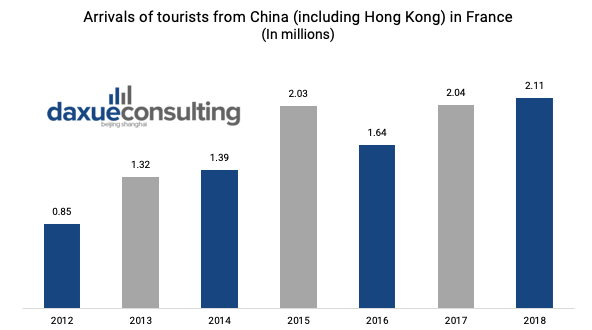
Data source: Statista, arrivals of tourists from China (including Hong Kong) in tourist accommodation in France from 2012 to 2018
The Chinese perception of Marseille
Why are Chinese so enthusiastic about this Mediterranean city?
As a port-hub originally founded by the Greeks, many Chinese associate Marseille with the Mediterranean, beautiful landscapes and French fashion. But beyond these superficial perceptions, Marseille and China have deeper connections.
Since 1987, Shanghai and Marseille have become sister cities. Moreover, the 2018 Belt and Road Initiative conference was held in Marseille, boosting Marseille and China business investment.
Politically, the establishment of Chinese consulate-general’s branch office in Marseille demonstrated this city’s political significance for both countries. In terms of education, Aix-Marseille University has opened a joint institute with the Wuhan University of Technology in China, and the kedge Business School shares executive partnerships with Shanghai Jiao Tong University. Relying on its innovation dynamics, Marseille is upgrading its image and becoming more familiar to Chinese people.
Qualitative analysis of Chinese perceptions of Marseille

Source: Baidu index of Marseille 马赛 Chinese perceptions of Marseille
Chinese people’s discussion scope about Marseille centers on its popular tourist spots, cultural activities and products. Besides Marseille, Chinese tourists also show great interests in other cities in South France like Nice, Gannes and Provence. As for cultural activities, Marseille’s football matches are absolutely a sensation in China. Chinese netizens also frequently search for Marseille’s brands and products like Marseille soap, L’Occitane and Compagnie de Provence.

Source: Zhihu & Weibo, Chinese people’s various concerns about the security in Marseille.
However, Chinese tourists consider Marseille to be poorly policed. This is due to frequent demonstrations, thefts and robberies. Plus, Chinese tourists’ inclination for showing off wealth makes them more susceptible to pickpocketing. “Is it really safe there?”, “Are there many thieves?”, “Are manifestations of the yellow vest movement over yet?” such queries are often present in Marseille related posts on China’s social media. In fact, the security of France has been negatively reported by media in recent years, not just Marseille.
Footprints of Chinese KOLs in Marseille
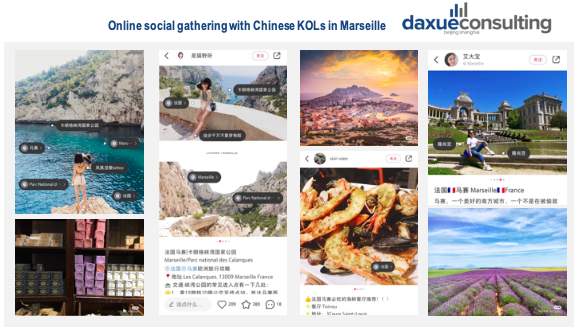
Source: Red, Online social gathering with Chinese KOLs in Marseille
Recommendations and sharing of KOLs about Marseille largely direct Chinese people’s perception of this city. By focusing on Chinese social media like Red, Weibo and WeChat, Chinese KOLs have great interests in seeking excitement in Marseille. They like experiencing new situations and unique trips. Thus, exploring niche and wild landscapes like Verdon Gorge Grand Canyon, Calanques national park and seaside villages are their fondness. Because they can give their voice of loving life and chasing uninhibitedness by conquering desolate places. Just like a popular traveling blogger on Red shared, “I love the feeling of freedom and unfettered.”
Chinese KOLs also have a craze of sharing their liked local delicacy and shopping. “Traveling isn’t just about taking in beautiful scenery, it’s also important to enjoy local cuisines”, a Chinese traveling and food blogger commented on Red. Besides, it is indispensable for Chinese KOLs to take photos to record impressive dining experiences. And they will caption it “attendance (打卡) in an internet-famous restaurant”. If they find any adorable products and brands, they will also share them on social media. For example, Marseille soap, Le Petit Marseillais and Compagnie de Provence is harvesting more Chinese consumers through KOLs’ recommendations.
Marseille’s cultural output towards China
China has one million Olympique of Marseille fans
If you ask a Chinese football fan about their impression of Marseille, the answer will definitely be this city’s team, the Olympique of Marseille. Through leveraging China’s social media, this football club has attracted nearly a million followers on Weibo.
Besides, Marseille’s legendary player, Zidane also opened his personal account on Weibo in November 2018 and has more than 212,000 followers. Beyond its digital strategy in China, the Olympique of Marseille is also active in offline promotions. In 2018, it created a fan club in Shanghai. The president of the club Jacques Henri Eyraud attended the ceremony and said: “The establishment of this Shanghai fan club is the first step of entering the Chinese market, and we hope to have more comprehensive and in-depth cooperation with Chinese fans in the future.”
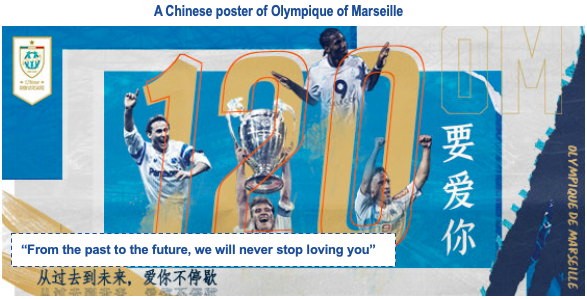
Source: Weibo, Chinese poster of the Olympique of Marseille
Marseille films rank highly in China, which in turn, puts the city in the map in modern Chinese literature
Marseille’s cultural output towards China goes far beyond sports. Marseille’s films, music and literature are also influential to Chinese, partly thanks to French filmmaker Luc Besson favoring Marseille as a location for film shooting. The symptoms of this city’s intense renovations in the 1990s were indicated in the action film series Taxi, which were highly appreciated by Chinese audiences. Douban, China’s authoritative film rating site, gave the Taxi series a 7.8 / 10 rating, same as the contemporaneous French film Jeux d’enfants (2003). In literature, French writer Alexandre Dumas’s magnum opuses, like the Count of Monte Cristo, the Three Musketeers and the Man in the Iron Mask, inspired many Chinese readers and draw them to visit Marseille. Additionally, there are also many depictions in Chinese novels about this city. For example, Chinese popular scientific fiction the Three Body Problem mentioned Marseille as a large-scale science research base.

Source: Douban, Chinese poster of Taxi 5
Chinese tourism in Marseille
Chinese tourists’ top destinations in Marseille
Ctrip lists the top three attractions of Marseille for Chinese tourists by three categories: popular landscapes, must-see museums and historical discovery. Known as the most beautiful canyon in Europe, Verdon Gorge is considered by Chinese visitors the most beautiful local place. Boating on the Sainte-Croix lake is a must-play activity for them. Another popular destination for the Chinese is the Château d’If. In center city, Chinese tourists like to take pictures in the old port and soak up the atmosphere of its fish market. Besides, the Notre-Dame-de-la-Garde basilica, the Panier district and numerous museums are preferred by Chinese tourists as for picturesque facades and historical value.
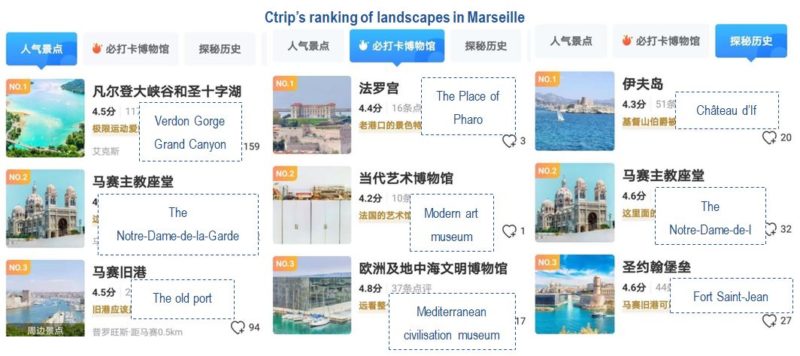
Source: Ctrip, ranking of landscapes and tourist sites in Marseille
Chinese tourists’ eating, living and shopping in Marseille
Restaurants serving local food, like Panisse, Madeleines and Moules Marinière, are popular with Chinese customers. O’Bidul, a seafood restaurant with authentic recipes and heart-warming service, is appraised by Ctrip as the most popular restaurant.
China’s wealth inflation allowed Chinese tourists to splurge on luxury hotels in Marseille. The hottest hotel in Marseille for Chinese tourists is InterContinental Marseille Hotel-Dieu, of which the cheapest room charges at least 30,000¥ for one night. In addition, Chinese tourists increasingly adopt Airbnb is as a cost-effective accommodation.
In terms of shopping, there are many super malls like Galerie Lafayette, Les Terrasses Du Port and Centre Commercial Bourse, which can satisfy Chinese customers’ various fashion demands. Also, many Chinese tourist make bulk purchases at local pharmacies and boutiques.
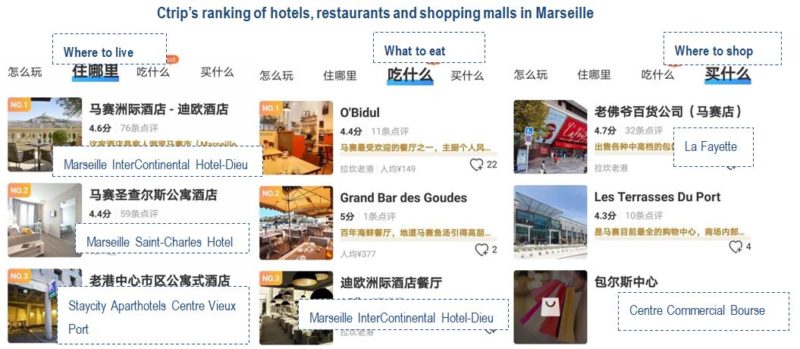
Source: Ctrip, ranking of hotels, restaurants and shopping malls in Marseille
Chinese interest in Provence, France was sparked by a soap opera
Lured by clusters of mauve flowers, Chinese tourists are conquering Provence in the form of sightseeing. Every July and August, groups of buses carrying thousands of Chinese visitors crowds the country lanes. Many French medias has reported Chinese people’s obsession with Provence, and are surprised they don’t go to Paris, but yearn for this remote landscape.
In fact, this Chinese craze stemmed from the Chinese drama shot in Provence, Dreams Link (一帘幽梦), which was on screen between 2007 and 2008. The lavender and sunflower fields, the French castles and the pure sky had root in the memory of the Chinese the frame of a France more romantic than ever.
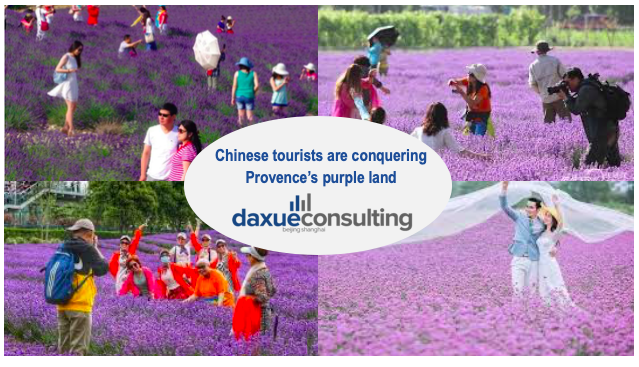
Source: Xiaohongshu & Weibo, Chinese tourists are conquering this purple land
There is no doubt that the Chinese boosted local economic development. They are bigger spenders than other foreign tourists. In Provence, the average daily expenditure, excluding hotels and meals, of the French is about 60 euros, for Americans it is 97 euros, however, for Chinese it is an amazing 170 to 300 euros. Hence, local tourism beneficiaries adopted various strategies to cater for Chinese tourists, like making everything in lavender purple, adding Chinese instructions in billboards, and promoting special souvenirs. Additionally, Provence has become the Garden of Eden for Chinese couples. In recent years, the trend of holding wedding or spending honeymoon in Provence is soaring for Chinese people. Because the Chinese translation of Provence includes the character Wàng (旺) which means ‘prosperity’.
What you should know about Chinese tourism in Marseille
Along with the boom in traveling abroad, China’s tourism is undergoing a consumption renewal towards niche destinations and customized tourism. Under this circumstance, knowing how to effectively reach these increasingly sophisticated travelers is a strategic advantage for Chinese tourism stakeholders. Digital marketing is an effective channel, and there are so many platforms to choose from. In combination with a KOL marketing strategy, niche and lesser-known destinations can put themselves on the radar for Chinese travelers. As demonstrated by the success of the Olympique of Marseille, Weibo is useful to accumulate consumer awareness in China.
Additionally, Xiaohongshu can also be leveraged to promote destinations including stores, restaurants, and hotels. WeChat is also not to be overlooked, not only running a WeChat account for promotion, but also local vendors can set up WeChat pay for Chinese tourists in Marseille.

Source: Zhihu, digital tourism marketing channels in China
The economic links between Marseille and China
Beyond its tourists, China’s businesses are flocking to Marseille.
Marseille’s economy is surging under the cooperation with Chinese companies. Many international groups having long traditions of working in China such as Airbus Helicopters and CMA CGM shipping. Chinese magnates such as Weichai Power, PetroChina, Watchdata Technologies and Tinno Mobile have all invested in Provence. In March 2019, Marseille-Fos gained a 105 million euros investment from Quechen Silicon Chemical to build its European silica factory. This expensive contract is one of the largest Chinese greenfield investments in France.
Now, many Marseille-China direct sea and air routes are planned.
Along with Marseille’s transportation connections being expanded, more investments from China will be boosted. “With its unique geographical location and abundant resources, Marseille can play an active role.” Fei Zhaohui, president of the Paris branch of China’s Export-Import Bank, said at the 2018 Belt and Road conference in Marseille. In the future, Marseille-China trade will advance as Marseille can act as a bridge between China, south Europe and North Africa.
The popular industries, brands and companies of Marseille in China
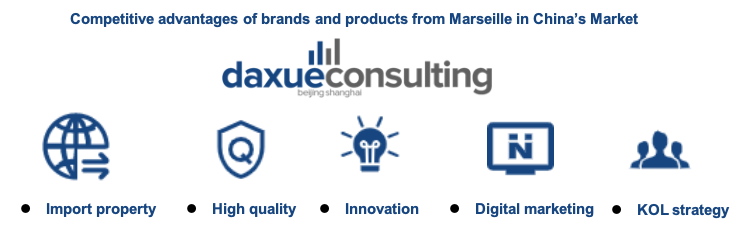
Competitive advantages of brands and products from Marseille in China’s market
Skin care products
Soap produced in Marseille is a well-known traditional craft for Chinese. It boasts a high reputation in China by means of its beauty benefits and scents of olive oil or lavender. Now, Marseille soap is more than a must-buy cosmetic for Chinese tourists, as it is a symbol of the city.
Le Petit Marseillais and Compagnie de Provence, niche skin care brands in China, are extensively shared by Chinese beauty bloggers on social media. These two brands’ shower gels have attracted many loyal Chinese customers because of their various and innovative fragrances. Many second-time purchasing customers commented that they love their attractive aroma. However, without accessing China’s market, the main purchasing channel of these two brands for Chinese customers is through Daigou or Haitao.
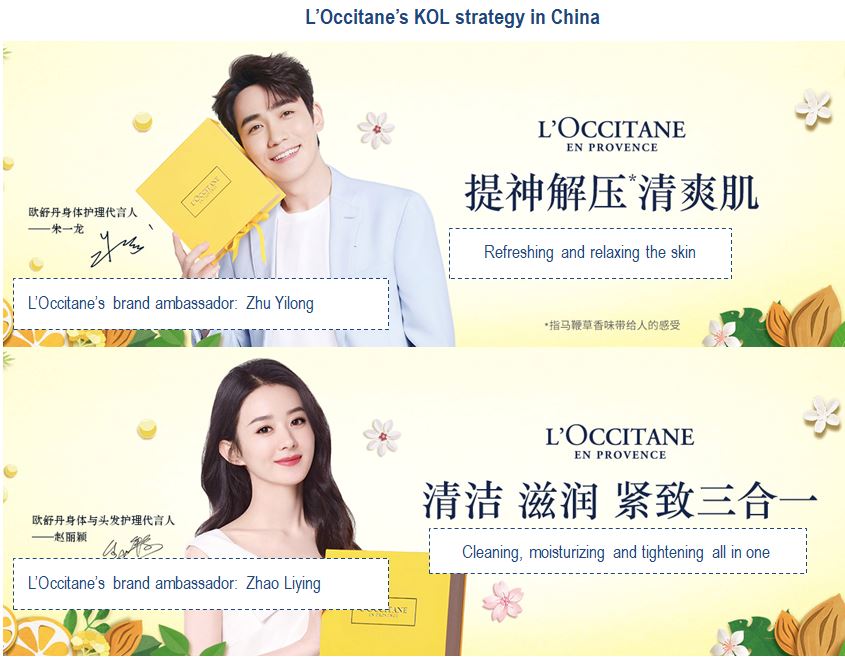
Source: L’Occitane, L’Occitane’s KOLs strategy in China.
If Marseille’s skin care products are the crown, L’Occitane is definitely the pearl on top. Now, China has become L’Occitane’s third biggest market in the world with 197 million euros sales revenue in fiscal year 2020, behind America and Japan. Its success is attributed to its digital and KOL marketing strategies in China. Vigorously participating in China’s various e-commerce promotions, L’Occitane focuses more on online selling. In Chinese ‘6.18’ online shopping carnival, relying on its high customer reputation and imported brand property, L’Occitane’s turnover increased by 170% compared to 2019. Meanwhile, it leverages Chinese celebrity influence to acquire more customers. Among 100 comments of its popular hand cream, 54 purchasers spoke bluntly that Zhu Yilong, the brand ambassador of L’Occitane, was their buying stimulus. This Chinese male star has acted in several popular Chinese TV series and films, and he has 25 million fans on Weibo.
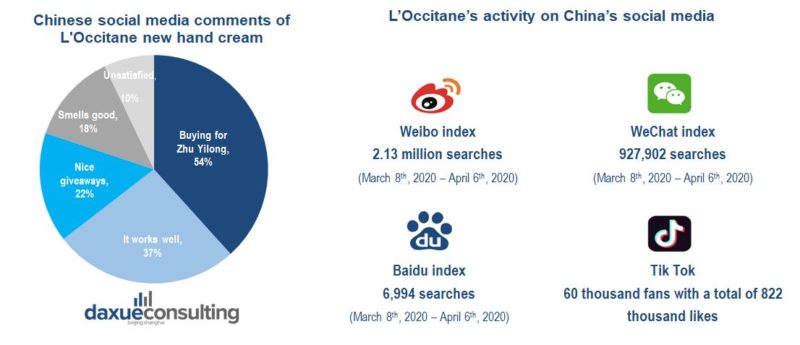
Data source: Digitaling, L’Occitane’s relative comments and activity on China’s social media.
Alcohol
Chinese wine drinking habits are changing at a quick pace. However, China’s national wine production has plummeted, and the demand of imported wine has soared. Under this circumstance, the unique geographical advantage makes wines from Provence highly appreciated by Chinese consumers. From January to June 2019, France is China’s second largest wine exporter with 351 million dollars total annual in exports.
Hence, as one of France’s prominent wine production zones, Marseille has great potential in China’s wine market. French wines & spirits giant Pernod Ricard is penetrating China’s alcohol market. China accounts for 9% of Pernod Ricard’s net sales, becoming its third largest market in the world. Additionally, its turnover in China increased 21% in fiscal year 2019, while Chinese baijiu and whisky showed robust momentum. Additionally, targeting China’s strongly evolving spirits market, this alcoholic drink tycoon has accelerated its layout in China. Pernod Ricard’s whisky distillery in Sichuan, as China’s first spirits factory with foreign investments, started the construction in 2019, and the production is scheduled to start in 2021.
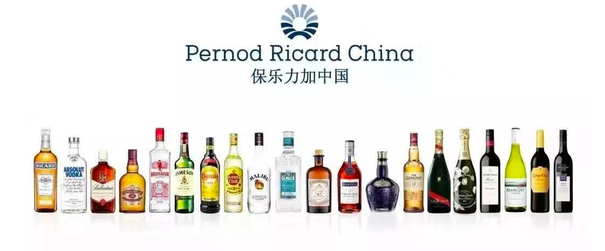
Source: Pernod Ricard, Pernod Ricard’s business in China
Logistics
CMA CGM China (达飞轮船), a subsidiary of Marseille’s CMA CGM Group, has served 28 years in China. With 51 offices nearly covering all major port cities across China, CMA CGM China has evolved into an industrial leader. It implements “Customer Centricity” strategy to provide high-quality, customized and cost-effective shipping solutions for Chinese customers. Beyond an industrial giant, CMA CGM China is committed to environment protection and marine biodiversity preservation by reducing carbon discharge. Besides, in order to facilitate customer serving process, CMA CGM China has opened its official account on WeChat, which allows customers to discover more about them and submit LOI documents remotely.
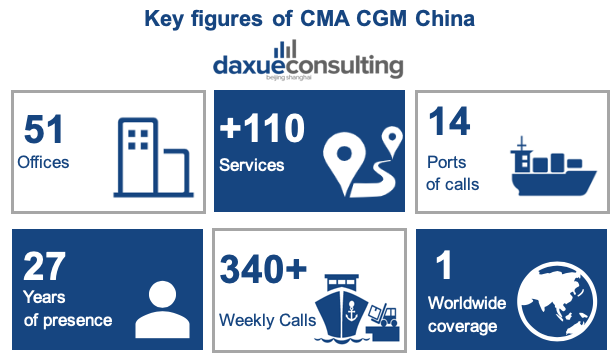
Source: CMA CGM, key figures of CMA CGM China
During the COVID-19 outbreak, CMA CGM Group proved its resilience and team’s expertise. Due to Chinese government’s strict measures to restrain the epidemic, CMA CGM China’s business suffered an obvious decline. Shanghai Yangshan Port, China’s busiest port, saw a 17% plunge in cargo volume under the impact of COVID-19. However, CMA CGM effectively controlled its cost and limited the volume shrinkage at optimistic 4.6%. Moreover, its operating margin surprisingly increased to 13.5% and realized positive net result of USD 48 million in the first quarter of 2020. Besides, CMA CGM Group has donated 50,000 FFP2 (EU N95 standard) masks to China to help Chinese government in controlling the pandemic, which reflecting its close bond with China and a great sense of social responsibility.
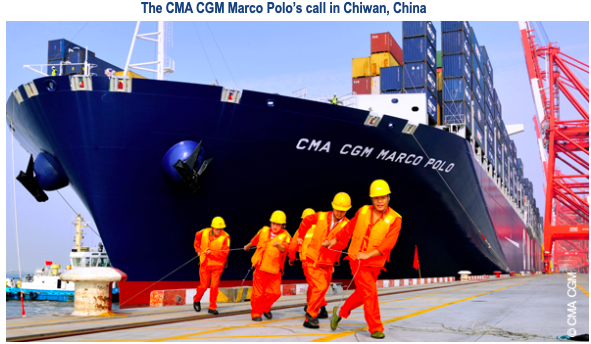
Source: CMA CGM, CMA CGM Macro Polo’s call in Chiwan (China)
Future prospects for Marseille and China
Marseille is the fastest growing interconnection hub in Europe, and it is striding towards a metropolis leading the world having close contacting with China. Yet Marseille has showed its significance in the diplomacy, and it will be strengthened with Belt and Road policy’s further implementation. As for tourism, Marseille is one of Chinese tourists’ top destinations, aiding local economic advancement. Meanwhile, relying on its geographic advantages and abundant resources, this port city will be more attractive as a goldmine for Chinese companies to invest there. Contrary, although the organization and HR of Marseille’s famous brands and companies in China were impacted by the epidemic, they will certainly be more competitive in China’s market following the country’s economic recovery. If you want to know more information about China’s market, please send e-mail to dx@daxueconsulting.com
Learn how to reach Chinese travelers abroad with our Chinese Duty Free Consumption report
Listen to 100 China entrepreneur stories on China Paradigms, the China business podcast
Listen to China Paradigm on Apple Podcast



